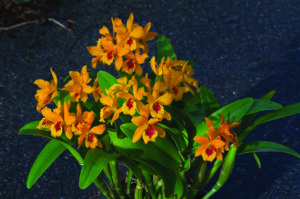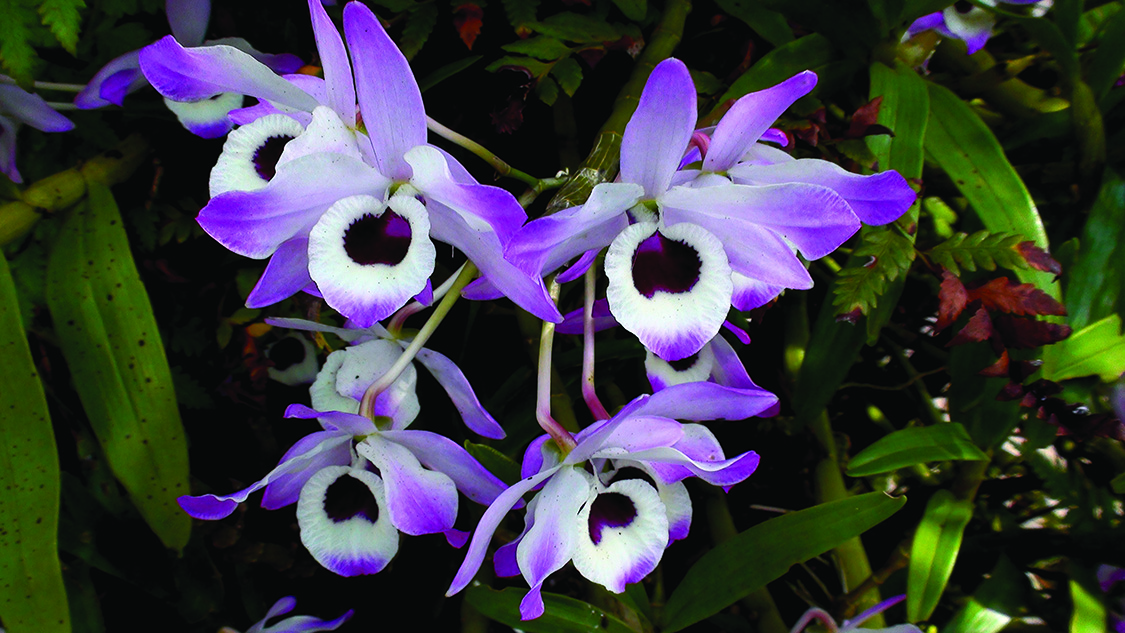
Gary R. Smith said his first orchid was a Cattleya plant and that it’s still alive and well, 30 years later, comparing it to a “puppy that’s grown into a Great Dane.” (Photo by Gary R. Smith)
For its legion of dedicated admirers, the show-stopping beauty of orchids offers a bountiful visual feast anytime and anywhere.
But for Mid-Atlantic orchid afficionados, late winter and early spring are especially bountiful, thanks to local clubs scheduling shows nearly each weekend from February through April, with many members gladly traveling to each event.
The crowded timing makes sense because, according to the American Orchid Society, this is when the spectacular specimens are in bloom, for the most part.
The Susquehanna Orchid Society (of Pennsylvania’s lower Susquehanna Valley) kicked things off with it’s annual gala show on Feb. 3-5 at the Milton & Catherine Hershey Conservatory.
The National Capital Orchid Society’s event followed on Feb. 17-19 at Homestead Gardens in Davidsonville, Md.
NCOS describes itself as “a diverse group of orchid enthusiasts in the greater Washington D.C. area who collect, grow and share information on orchids. Founded in 1947, we have members in the District of Columbia, Maryland, Virginia and West Virginia.”
The Maryland Orchid Society’s Annual Show and Sale is timed to take place during the second weekend of the Maryland Home and Garden Show in Lutherville Timonium, March 10-12.
Additional events include The Southeastern Pennsylvania Orchid Society’s Annual International Show at the Oaks Expo Center in suburban Philadelphia March 31 and April 1-2.
The Virginia Orchid Society’s event is scheduled for March 3-5 at the Lewis Ginter Botanical Garden in Richmond.
Many area society members actively participate in and attend numerous activities and functions, especially taking advantage of the relatively easy driving distance to each respective Annual Show.
Gary R. Smith, who chairs the 2023 NCOS Show, is also registrar for the MOS Show. Smith, a native of New Windsor in Carroll County, met his spouse of 15 years, who he names as the more prolific orchid grower in the family, while attending MOS meetings.
Not having a particularly green thumb hasn’t prevented him from the enjoyment he’s gotten gardening on a “casual basis,” since childhood, Smith noted, happily recalling his hobby of growing African Violets under a light stand. “They seemed to do quite well,” Smith added. He later went on to study plant ecology in college.
His orchid growing adventure began with a spur of the moment purchase during a trip to the Philadelphia Flower Show in the early 1990s.
Not wanting to leave without bringing something home, Smith spotted a small orchid specimen, not even in bloom.
“My first was a Cattleya plant, full name Cattlian the Gold Digger ‘Fuchs Mandarin’, AM/AOS. It’s still alive and well, 30 years later, a ‘puppy’ that’s grown into a ‘Great Dane,’” Smith happily reported.
The orchid’s name can be explained, according to Smith:
• Cattlianthe: A man-made cross of the two natural genera Cattleya and Guarianthe;
• Gold Digger: A specific named hybrid;
• Fuchs Mandarin: A specific clone of the Gold Digger hybrid. Many orchids are mass produced via cloning. “At the time, I thought I was buying a seedling,” he said. “I learned later that it was cloned;” and
•AM/AOS: The original plant won an Award of Merit from the American Orchid Society.)
Adding that Cattleya varieties were commonly known for corsages years ago, Smith also offered the following summary of other better known and widely grown orchid genera:
• Phalaenopsis: Moth orchid. Quite available and generally easy to grow;
• Cymbidium: Once very popular but now often too large for modern growing spaces. Common in San Francisco where they practically grow outdoors;
• Dendrobium: Widely ranging from little curiosities to large stunning plants;
• Vanda: Big round flowers on “air plant” type plants down to small starry flowered miniatures;
• Slipper Orchids: A group including Paphiopedilum and Phragmipedium. There’s a ton of hybridizing still occurring, and many people are crazy for these; and
• Miniature Orchids: Pleurothallis, Masdevallia, Dracula (Yup, that’s the actual name).
This will be the NCOS’s fourth Annual Show hosted by Homestead Gardens. Previously the event, as well as a Fall Show were held at Behnke’s Nursery in Beltsville prior to its closing.)
While the majority of displays will feature tropical or hybrid orchids, the Smithsonian Environmental Research Center will be hosting a session on native area orchids.
Marc Kiriou, chair for the 2023 MOS Show, reports that the group has been around since 1953 and putting on the annual show for 58 years, the last four with the Maryland Home and Garden Show held in Lutherville-Timonium. There are currently about 100 group members.
Kiriou has personally been growing orchids for about eight years and a society member for five.
“I have always had an interest in growing plants. I started growing carnivorous plants in my teens. I never really gave orchids much thought because I assumed, as most people do, that Phalaenopsis were the only orchids out there and they really didn’t pique my interest.
One December I was walking through the garden center of Home Depot, and I saw what I later learned was a Paphiopedilum Orchid. I was immediately intrigued so I bought it. This one purchase led me down the rabbit hole of orchids and to the realization that approximately two-thirds of the world’s flowering plants were in fact orchids, and I have been growing ever since,” Kiriou added.
(Writer’s note: For more information, visit www.ncos.us/; www.marylandorchids.org/; susquehannaorchid.org/; www.sepis.org/; or www.vaorchidsociety.org/.)




